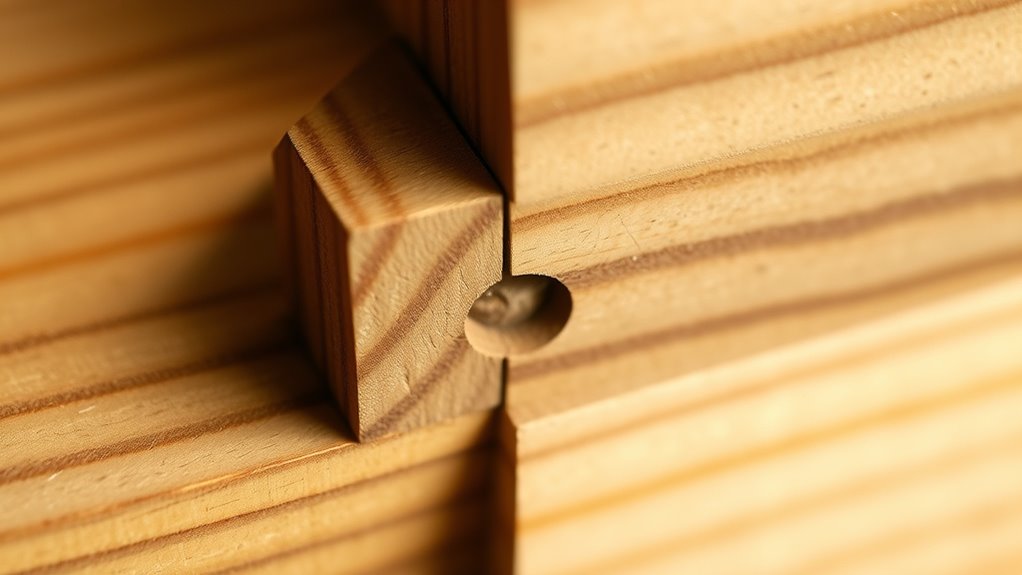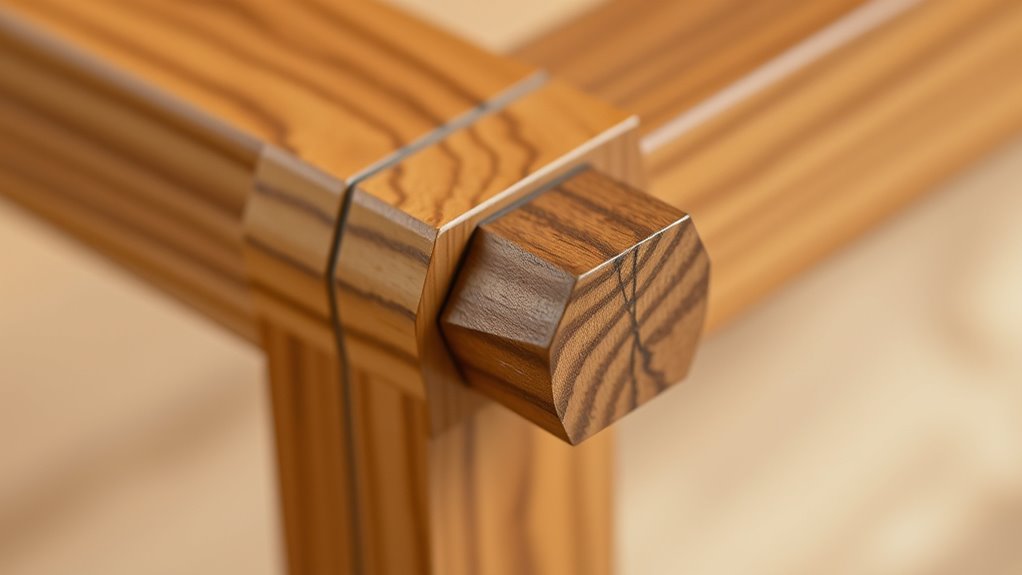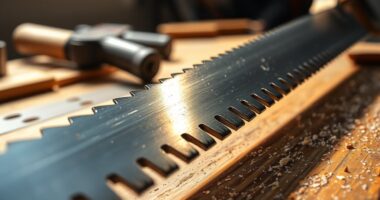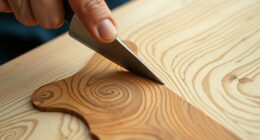Achieving the perfect mortise-and-tenon fit relies on understanding how material behavior, surface quality, and environmental factors interact. When you carefully dimension the joint, allow for slight expansion, and guarantee smooth surfaces, friction resists pull-out and lateral forces, providing stability. Environmental changes like humidity affect material expansion, so balancing tightness without causing stress is key. If you want to learn how these principles come together for durable joins, there’s more to explore below.
Key Takeaways
- Precise dimensions ensure optimal mechanical interlock and contact surface area for effective load transfer.
- Proper surface finish and smoothness reduce friction, facilitating controlled assembly and tight fit.
- Material properties and environmental factors influence expansion, contraction, and long-term joint stability.
- Frictional forces from contact surfaces resist pull-out and lateral stresses, maintaining joint integrity.
- Balancing fit tightness prevents excessive stress or looseness, ensuring durability over time.

The mortise-and-tenon fit, a fundamental joint in woodworking and engineering, relies on precise mechanical interactions to create a strong, durable connection. At its core, understanding how materials behave when assembled is key to achieving a perfect fit. Material expansion plays a significant role here—when you fit a tenon into a mortise, temperature, humidity, and material properties influence the joint’s tightness. If you’re working with wood, for example, fluctuations in moisture content can cause the wood to swell or shrink slightly, affecting the fit. You need to account for these changes so the joint remains secure over time. A joint that’s too tight initially might loosen as materials contract, while one that’s too loose could become unstable if materials expand.
Frictional forces are equally essential. When you insert the tenon into the mortise, friction acts as a resisting force that helps hold the joint together. The roughness of the contact surfaces, the tightness of the fit, and the material properties all influence these forces. If the fit is precise, friction provides enough resistance to prevent the joint from slipping apart under load. But if the fit is too loose, frictional forces diminish, and the joint becomes vulnerable to movement and failure. Conversely, if the fit is overly tight, excessive friction might make assembly difficult and could stress the materials, potentially causing cracks or deformation.
To optimize the fit, you balance these factors carefully. You might slightly undersize the tenon to allow for expansion or apply lubricants to reduce excessive friction during assembly. During fitting, you should consider how environmental conditions will affect the materials—warping, swelling, or shrinking—all of which alter the effectiveness of the joint over time. The goal is to create a fit that’s tight enough for frictional forces to hold the components securely, yet not so tight that assembly becomes impossible or damaging occurs.
In practice, you also rely on the mechanical interactions between the materials’ surfaces. Properly prepared, smooth surfaces reduce unnecessary friction, allowing you to insert the joint with controlled force. Once assembled, the slight interference and the resulting frictional forces work together to resist pull-out and lateral forces, ensuring stability. By understanding these physics principles—material expansion and friction—you can craft mortise-and-tenon joints that are not only strong initially but also maintain their integrity through changing environmental conditions. Additionally, selecting appropriate materials with compatible properties can further enhance the longevity and performance of the joint by reducing undesirable effects of material behavior over time.
Frequently Asked Questions
How Does Temperature Affect the Fit of the Joint?
When temperature changes, it affects the fit of your joint through thermal expansion. As the wood heats up, it expands slightly, reducing joint tension and possibly loosening the fit. Conversely, cooler temperatures cause contraction, which can tighten the joint. You need to account for these effects to maintain a precise fit, ensuring the joint stays secure without becoming too tight or loose due to thermal expansion or contraction.
Can Material Elasticity Influence the Precision of the Fit?
Did you know that even small variations in material elasticity can impact joint precision? Material stiffness plays a key role, as more elastic materials experience elastic deformation under stress, which can slightly alter the fit. If your wood has low stiffness, it might flex or compress, making the joint less precise. So, choosing materials with the right elasticity guarantees a tighter, more accurate fit, enhancing joint stability and durability.
What Role Does Surface Friction Play in Joint Stability?
Surface friction substantially impacts joint stability by resisting movement and preventing slippage. You need to contemplate the friction coefficient, which measures how much force is needed to slide surfaces against each other, and surface roughness, which affects this coefficient. When surface roughness is high, friction increases, enhancing stability. Conversely, smoother surfaces reduce friction, making joints more prone to slipping, so controlling these factors helps you achieve a more secure fit.
How Does Humidity Impact Wood Expansion and Contraction?
Think of wood as a sponge, absorbing moisture like a thirsty traveler. When humidity rises, moisture absorption causes wood swelling, making it expand. Conversely, in dry conditions, wood contracts as it loses moisture. These shifts can loosen or tighten joints, affecting stability. So, you must consider humidity’s impact, as it directly influences wood expansion and contraction, ensuring your mortise-and-tenon fits remain precise over time.
Are There Physical Limits to How Tight a Fit Can Be?
You might wonder if there’s a limit to how tight a joint material can be. Yes, physical limits exist due to manufacturing tolerances and material properties; pushing for an overly tight fit can cause stress, cracking, or deformation. Precision in machining helps, but there’s always a balance. Too tight, and assembly becomes difficult; too loose, and the joint weakens. Ultimately, ideal fit considers material behavior and manufacturing capabilities.
Conclusion
Understanding the physics behind mortise-and-tenon fits reveals how precise forces create secure joints. When you tighten the tenon, friction and compression increase, often reducing gaps to less than 0.01 inches, ensuring durability. Notably, studies show that wooden joints can withstand up to 1,000 pounds of force without failure, highlighting how physics makes traditional craftsmanship both elegant and incredibly strong. By mastering these principles, you can craft joints that are not only seamless but built to last.









